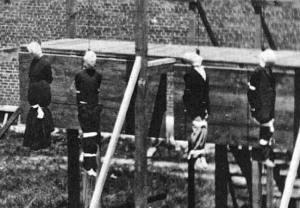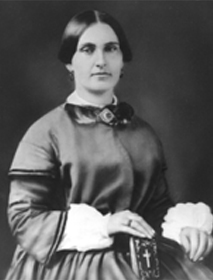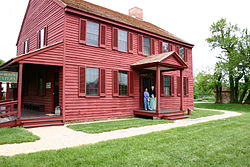Convicted Lincoln assassination conspirator
Mary Eugenia Jenkins was born in Maryland in 1823. As an adolescent she attended a Catholic seminary for girls in Virginia, but at sixteen she married John Surratt, at least ten years her senior, and in 1840 settled with him in Prince George’s County, Maryland. In the early years of their marriage the Surratts prospered as a result of John’s success as a planter, which allowed him to expand his land holdings and open a general store and tavern, making up the core of the community that came to be known as Surrattsville (now Clinton). In 1854, a post office was even established in town, with John as its first postmaster. John’s earlier achievements were undermined, however, by his excessive drinking, which led to neglect of his farm and crops and a steady decline in his fortunes. In August 1862, John died. The Surratts’ eldest son Isaac (b. 1841), having taken a job as a pony-express rider in Mexico, left Mary Surratt alone to care for her two younger children, Anna (b. 1843) and John, Jr. (b. 1844).
Surratt struggled to manage what remained of the family’s holdings in Surrattsville, but she found it increasingly difficult, not least of all because John, Jr. showed so little interest in helping on the farm. By fall 1864, Mary Surratt had moved with John, Jr. and Anna to a house on H Street in Washington, D.C., which her husband had purchased in 1853 and which she converted into a boardinghouse. Happily for the Surratts, the boardinghouse did quite well, with a small number of steady boarders and the constant flow of more transient traffic through the federal capital during the war.
As early as 1863, John Surratt, Jr. – a loyal Southerner like his late father – began serving the Confederacy as a courier. In connection with this work, and with his college studies, John brought a number of people home to H Street, some of whom would later become entangled in the assassination conspiracy. In the spring of 1863, John introduced his mother to a school chum named Louis Weichmann, who took up residence in the Surratt boardinghouse in November 1864. By January 1865, John had met and become good friends with the ardent secessionist and actor John Wilkes Booth. Subsequently Booth was a regular visitor to H Street as well. German immigrant and assassination co-conspirator George Atzerodt also stayed at the boardinghouse for a few days in February 1865, until Mary Surratt evicted him for excessive drinking. Posting as a Baptist preacher, Lewis Powell – later found guilty of the 14 April attack on Secretary of State William H. Seward – lodged at the Surratt boardinghouse for three days in March.
It was not long after the shooting at Ford’s Theater that government investigators first descended on the boardinghouse. At approximately 2:30 on the morning of 15 April, several officials arrived and demanded to search the house in connection with the murder of the President. It appears that these men were looking for John, Jr., whom they believed at the time to have been the one to assault Seward. On the evening of the 17th, two detectives and two army officers returned, this time to arrest Mary Surratt and the rest of the people remaining in the house (Weichmann had slipped out on the 15th and was arrested that day; other boarders, disturbed by the crowds gathering around the house, had moved out on the 16th). Of the five who were arrested, all were women, with the exception of Lewis Powell, who arrived in disguise at the last, and for him most inopportune, moment. John Surratt, Jr., was nowhere to be found, and Booth had already escaped across the Potomac.
Mary Surratt and the others were questioned intensively at the headquarters of General Christopher Augur, commander of the Union troops in the capital, and the women were taken to the Old Capitol Prison, where they were incarcerated. Although the other women arrested with her (including Anna Surratt) were subsequently released, Mary Surratt was not. Instead, along with Atzerodt, Powell, and five others (Samuel Arnold, David Herold, Dr. Samuel A. Mudd, Michael O’Laughlin, and Edward Spangler) Mary Surratt was charged in the conspiracy to assassinate the president and subjected to a trial by a military commission. The trial began on 11 May and ended on 28 June. All eight were found guilty in varying degrees, and on 5 July, when President Andrew Johnson issued his orders in connection with the commission’s verdict, four were sentenced to hang, Mary Surratt among them. Gallows for Surratt, Herold, Atzerodt, and Powell were swiftly constructed, and on 7 July 1865, despite all expectations that her sentence would be converted, Mary Surratt was executed.

The Assassination Conspirators Hang - from left: Mary E. Surratt, Lewis Powell, George Atzerodt, David Herold. Photo by Alexander Gardner.
The legitimacy of a military commission trying a case involving civilians, and the quality of both the investigation and the evidence supplied during the trial (particularly in her case) have continued to be matters of steady debate for well over a century. Doubts about Mary Surratt’s guilt were from the start exacerbated by her own unwavering claims – even to her priest – about her innocence. It does not help the cause of the prosecutors or the commission with its guilty verdict, or President Johnson with his determination to execute Surratt and the others as quickly as possible, that John Surratt, Jr., though finally captured and brought to trial in 1867, walked away free and lived until 1916.
- Elizabeth D. Leonard [Encyclopedia of the American Civil War, pages 1909-1910]
Additional Lincoln Assassination resources can be found here.
For further reading:
Bryan, George S. The Great American Myth: The True Story of Lincoln’s Murder (1990).
Busch, Francis X. Enemies of the State (1954).
DeWitt, David M. The Judicial Murder of Mary E. Surratt (1895; reprint, 1970).
Eisenschiml, Otto. Why Was Lincoln Murdered? (1937).
Moore, Guy W. The Case of Mrs. Surratt: Her Controversial Trial and Execution (1954).
Trindal, Mary E., and Elizabeth S. Mary Surratt: An American Tragedy (1996).
Turner, Thomas Reed. Beware the People Weeping: Public Opinion and the Assassination of Abraham Lincoln (1982).




What happened to the Jesuit Priests who used to meet at the Surratt boarding house in Washington D.C.or the army that Napoleon had in Mexico which was going to help the Confederates win the Civil war?
Pingback: The Lincoln Assassination: New research unravels old myths | This Week in the Civil War